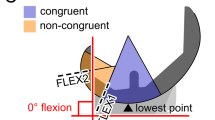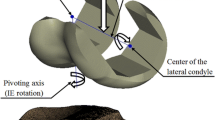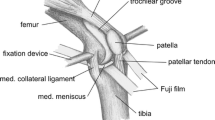Abstract
The tibiofemoral articulating interfaces of six high flexion knee designs were examined using a standard testing protocol developed by Harris et al. [J Biomech 32:951–958 (1999)] to investigate the polyethylene insert contact areas and pressures. A load of 3600 N was applied for 10 s at 0, 30, 60, 90, 110, 135 and 155° of flexion. Contact areas and pressures at the femoral–polyethylene insert interface were measured with a I-scan 4000 system. Up to 110°of flexion, the VANGUARD RP HI-FLEX showed the highest contact area and lowest pressure. At the deep flexion angles, contact area decreased and contact pressure increased significantly in all knees. The NexGen series showed a constant contact area throughout the various flexion angles. In general, all high flexion knees could result in almost point contact in an extremely high range of motion.
Résumé
Le but de cette étude est d’étudier l’interface fémoro-tibiale ainsi que les surfaces contacts et les pressions de l’insert polyéthylène sur 6 modèles de prothèses totales du genou permettant une grande flexion. Matériel et méthode: ces six interfaces articulaires fémoro tibiales ont été examinées sur six modèles différents de prothèses totales du genou avec grande flexion et un protocole mis en place par Harris et Collaborateurs. Une force de 3.600 newtons a été appliquée pendant 10 secondes à 0, 30, 60, 90, 110, 135 et 155 degrés de flexion. Les points de contact et les pressions ont été évalués avec un système I-scan 4000. Résultats: au dessus de 110 degrés de flexion la prothèse de type VANGUARD RP HI-FLEX montre une meilleure surface de contact avec les pressions les plus basses. Lorsque l’angle de flexion est très élevé, les surfaces de contact diminuent mais les pressions de contact augmentent de façon significative dans tous les genoux. La prothèse NEXGEN montre des points de contact constants quel que soit l’angle de flexion. Conclusion: les prothèses de genou avec grande flexion peuvent généralement entraîner des points de contact qui augmentent avec la flexion du genou.


Similar content being viewed by others
References
Andriacchi PT, Anderson GBJ, Fermier RW, Stern D, Galante JO (1980) A study of lower-limb mechanism during stair-climbing. J Bone Joint Surg 62A:749–757
Banks S, Bellemans J, Nozaki H, Whiteside LA, Harman M, Hodge WA (2003) Knee motions during maximum flexion in fixed and mobile-bearing arthroplasties. Clin Orthop Relat Res 410:131–138
Chapman-Sheath P, Bruce WJM, Chung WK, Morberg P, Gilles RM, Walsh WR (2003) In vitro assessment of proximal polyethylene contact surface areas and stresses in mobile bearing knees. Med Eng Phys 25:437–443
Collier JP, Mayor MB, McNamara JL (1991) Analysis of the failure of 122 polyethylene inserts from uncemented tibial knee components. Clin Onthop Relat Res 273:232–242
Dennis DA, Komistek RD, Stiehl JB, Walker SA, Dennis KN (1998) Range of motion after total knee arthroplasty: The effect of implant design and weight-bearing conditions. J Arthroplasty 13:748–752
Harris ML, Morberg P, Bruce WJM, Walsh WR (1999) An improved method for measuring tibiofemoral areas in total knee arthroplasty: a comparison of K-scan sensor and Fuji film. J Biomech 32:951–958
Hefzy MS, Kelly BP, Cooke TD (1998) Kinematics of the knee joint in deep flexion: A radiographic assessment. Med Eng Phys 20:302–307
Kim JM, Moon MS (1995) Squatting following total knee arthroplasty. Clin Orthop Relat Res 313:177–186
Lizaur A, Marco L, Cebrian R (1997) Preoperative factors influencing the range of movement after total knee arthroplasty for severe osteoarthritis. J Bone Joint Surg 79B:626–629
Maloney WJ, Schurman DJ (1992) The effects of implant design on range of motion after total knee arthroplasty. Clin Orthop Relat Res 278:147–152
Matsuda S, White SE, Williams II VG, McCarthy DS, Whiteside LA (1998) Contact stress analysis in meniscal bearing total knee arthroplasty. J Arthroplasty 13:699–706
Shoji H, Yoshino S, Komagamine M (1987) Improved range of motion with the Y/S total knee arthroplasty system. Clin Orthop Relat Res 218:150–163
Stiehl JB, Voorhorst PE, Keblish P, Sorrells RB (1997) Comparison of range of motion after posterior cruciate ligament retention or sacrifice with a mobile bearing total knee arthroplasty. Am J Knee Surg 10:216–220
Stukenborg-Colsman C, Ostermeier S, Hurschler C, Wirth CJ (2002) Tibiofemoral contact stress after total knee arthroplasty. Comparison of fixed and mobile-bearing inlay designs. Acta Orthop Scand 73:638–646
Sultan PG, Most E, Schule S, Li G, Rubash HE (2003) Optimizing flexion after total knee arthroplasty. Clin Orthopaed Relat Res 416:167–173
Szivek JA, Cutignola L, Volz RG (1995) Tibiofemoral contact stress and stress distribution evaluation of total knee arthroplasties. J Arthroplasty 10:480–491
Szivek JA, Anderson PL, Benjamin JB (1996) Average and peak contact stress distribution evaluation on total knee arthroplasties. J Arthroplasty 11:952–963
Wallace AL, Harris ML, Walsh WR, Bruce WJM (1998) Intraoperative assessment of tibiofemoral contact stresses in total knee arthroplasty. J Arthroplasty 13:923–927
Wright TM, Rimnac CM, Stulberg SD, Mintz L, Tsao AK, Klein RW, McCrae C (1992) Wear of polyethylene in total joint replacements. Observations from retrieved PCA knee implants. Clin Orthop Relat Res 276:126–134
Author information
Authors and Affiliations
Corresponding author
Rights and permissions
About this article
Cite this article
Shiramizu, K., Vizesi, F., Bruce, W. et al. Tibiofemoral contact areas and pressures in six high flexion knees. International Orthopaedics (SICOT) 33, 403–406 (2009). https://doi.org/10.1007/s00264-007-0478-7
Received:
Accepted:
Published:
Issue Date:
DOI: https://doi.org/10.1007/s00264-007-0478-7




